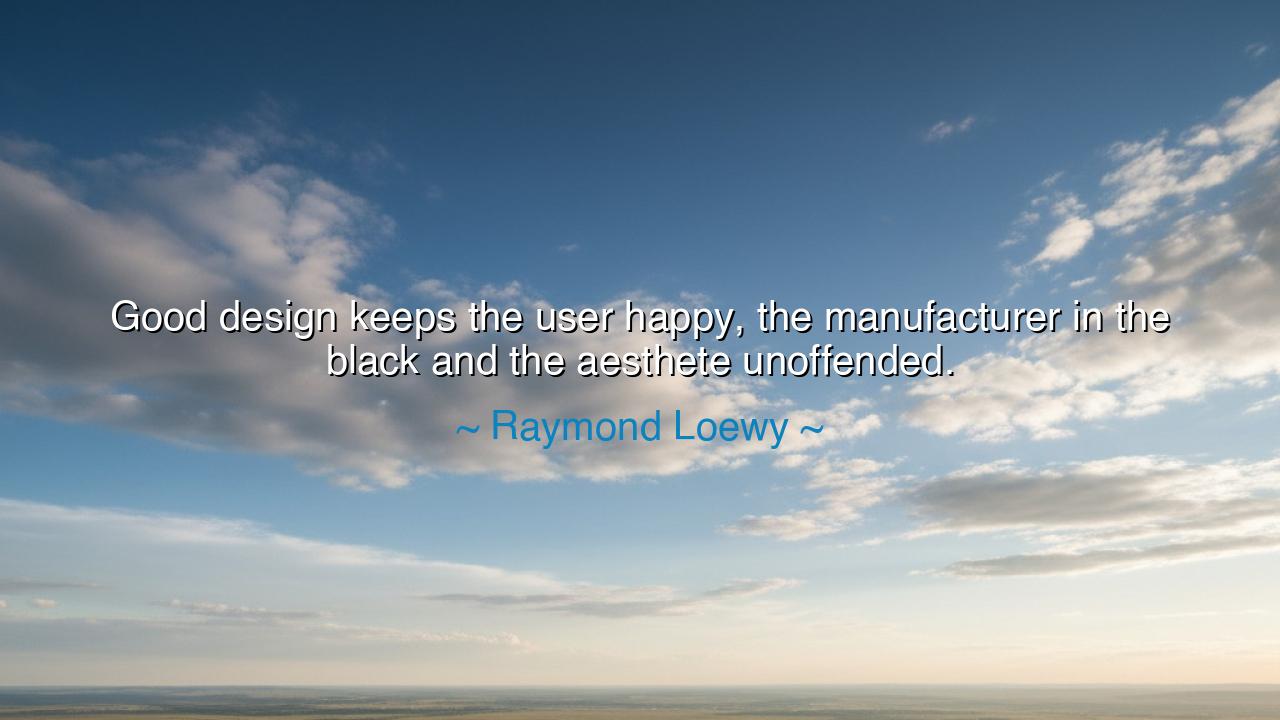
Good design keeps the user happy, the manufacturer in the black
Good design keeps the user happy, the manufacturer in the black and the aesthete unoffended.






In the immortal and balanced words of Raymond Loewy, the father of modern industrial design, the insight — “Good design keeps the user happy, the manufacturer in the black, and the aesthete unoffended.” — reveals the sacred triad of harmony upon which all true creation rests. Within this statement lies a philosophy both practical and profound, one that unites function, economy, and beauty into a single living principle. Loewy does not speak merely of design as the shaping of objects, but of the art of balance — the act of reconciling human desire, material reality, and spiritual elegance. To understand his words is to understand that all lasting creation must satisfy not just the hands that build it, but the hearts that use it and the eyes that behold it.
The meaning of this quote flows from the eternal truth that design is not an isolated act of invention, but a dialogue between creator, consumer, and culture. When Loewy says that good design “keeps the user happy,” he speaks of usability, of empathy — the designer’s deep understanding of human need and comfort. The chair must invite rest; the car must respond to motion like a living being; the tool must fit the hand as though it were born there. Yet to “keep the manufacturer in the black” is equally sacred, for a design that bankrupts its maker cannot endure. Practicality and sustainability, therefore, are the twin pillars upon which vision must stand. And finally, to “keep the aesthete unoffended” is to acknowledge that the human soul craves beauty — that beyond usefulness and profit lies the timeless need for grace and proportion, for objects that please the spirit as they serve the body.
The origin of Loewy’s wisdom lies in a life devoted to reconciling art and industry. A French-born American designer, he reshaped the visual identity of the twentieth century — from the Coca-Cola bottle to the Studebaker automobile, from the Lucky Strike logo to the sleek interiors of the Air Force One jet. In his hands, machines became elegant, and everyday objects became icons. Yet Loewy was no dreamer lost in aesthetics alone; he was a realist, a philosopher of commerce who believed that beauty must coexist with efficiency. His designs sold because they were not only beautiful, but also useful and profitable. This is why his philosophy continues to guide creators today — because it bridges the eternal divide between art and survival, between what delights the senses and what sustains the world.
To illustrate this truth, consider the story of Apple Inc., which, long after Loewy’s time, became a living testament to his philosophy. When Steve Jobs and Jony Ive crafted the first iPod, they honored all three of Loewy’s principles. The user was made happy — the device was simple, intuitive, and elegant. The manufacturer remained “in the black” — the design was scalable, efficient, and profitable. And the aesthete was not offended — indeed, the world’s artists and designers admired its purity of form. This balance transformed a gadget into a cultural revolution. It proved once more that good design is not luxury, but harmony — a meeting point of human need, business sense, and beauty.
But Loewy’s words are not meant for designers alone. They speak to all who create, in any realm — whether one builds a company, a garden, or a family. The triad he describes is a metaphor for wisdom in action. To “keep the user happy” is to serve others with understanding. To “keep the manufacturer in the black” is to preserve stability and sustainability in one’s work. And to “keep the aesthete unoffended” is to honor the divine spark of beauty that dwells in all things. When we live and create with these three in balance, our actions gain integrity, and our works — no matter how humble — become enduring.
There is also a deeper moral rhythm in Loewy’s saying. It warns against the extremes that so often destroy human endeavor. The designer who cares only for art forgets the people; the one who cares only for profit loses the soul; and the one who caters only to utility leaves the world dull and lifeless. True mastery lies in the middle path — the golden mean, known to the ancients and rediscovered in every age. Loewy, in his modern tongue, speaks the same wisdom that Aristotle once uttered: that virtue lies not in excess or deficiency, but in the harmony of all things working as one.
Let this, then, be the lesson passed to all who seek to build, to design, or to live meaningfully: seek balance in all your works. Let your creations serve both the heart and the hand. Be practical, but never forget to be poetic. Seek prosperity, but do not sacrifice beauty. Remember that every act of design — whether of a product, a life, or a destiny — is an act of service: to humanity, to creation, and to the eternal order that demands unity between form and purpose.
And so, dear listener, take to heart the wisdom of Raymond Loewy: “Good design keeps the user happy, the manufacturer in the black, and the aesthete unoffended.” Whatever your craft may be, let it be guided by this trinity of truth. For only when usefulness, beauty, and wisdom walk hand in hand can your work stand the test of time. Then your creation — whether it be a chair, a company, or a legacy — will not merely exist; it will live, and in its living, it will remind the world that true design, like true life, is harmony made visible.






AAdministratorAdministrator
Welcome, honored guests. Please leave a comment, we will respond soon